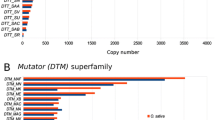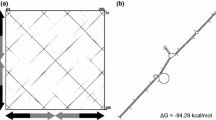Abstract
Transposable elements (TEs) have a significant impact on the evolution of gene function and genome structures. An endogenous nonautonomous transposable element nDart was discovered in an albino mutant that had an insertion in the Mg-protoporphyrin IX methyltransferase gene in rice. In this study, we elucidated the transposition behavior of nDart, the frequency of nDart transposition and characterized the footprint of nDart. Novel independent nDart insertions in backcrossed progenies were detected by DNA blotting analysis. In addition, germinal excision of nDart occurred at very low frequency compared with that of somatic excision, 0–13.3%, in the nDart1-4(3-2) and nDart1-A loci by a locus-specific PCR strategy. A total of 253 clones from somatic excision at five nDart loci in 10 varieties were determined. nDart rarely caused deletions beyond target site duplication (TSD). The footprint of nDart contained few transversions of nucleotides flanking to both sides of the TSD. The predominant footprint of nDart was an 8-bp addition. Precise excision of nDart was detected at a rate of only 2.2%, which occurred at two loci among the five loci examined. Furthermore, the results in this study revealed that a highly conserved mechanism of transposition is involved between maize Ac/Ds and rice Dart/nDart, which are two-component transposon systems of the hAT superfamily transposons in plant species.



Similar content being viewed by others
References
Bai L, Singh M, Pitt L, Sweeney M, Brutnell TP (2007) Generating novel allelic variation through Activator insertional mutagenesis in maize. Genetics 175:981–992
Baran G, Echt C, Bureau T, Wessler S (1992) Molecular analysis of the maize wx-B3 allele indicates that precise excision of the transposable Ac element is rare. Genetics 130:377–384
Bennetzen JL (2000) Transposable element contributions to plant gene and genome evolution. Plant Mol Biol 42:251–269
Bennetzen JL (2005) Transposable elements, gene creation and genome rearrangement in flowering plants. Curr Opin Genet Dev 15:621–627
Brutnell TP, Dellaporta SL (1994) Somatic inactivation and reactivation of Ac associated with changes in cytosine methylation and transposase expression. Genetics 138:213–225
Brutnell TP, May BP, Dellaporta SL (1997) The Ac-st2 element of maize exhibits a positive dosage effect and epigenetic regulation. Genetics 147:823–834
Chen J, Greenblatt IM, Dellaporta SL (1987) Transposition of Ac from the P locus of maize into unreplicated chromosomal sites. Genetics 117:109–116
Conrad LJ, Brutnell TP (2005) Ac-immobilized, a stable source of Activator transposase that mediates sporophytic and gametophytic excision of Dissociation elements in maize. Genetics 171:1999–2012
Courage-Tebbe U, Doring HP, Fedoroff N, Starlinger P (1983) The controlling element Ds at the Shrunken locus in Zea mays: Structure of the unstable sh-m5933 allele and several revertants. Cell 34:383–393
Dooner HK, Belachew A (1989) Transposition pattern of the maize element Ac from the Bz-M2(ac) allele. Genetics 122:447–457
Ebana K, Kojima Y, Fukuoka S, Nagamine T, Kawase M (2008) Development of mini core collection of Japanese rice landrace. Breed Sci 58:281–291
Eisses JF, Lafoe D, Scott LA, Weil CF (1997) Novel, developmentally specific control of Ds transposition in maize. Mol Gen Genet 256:158–168
Elrouby N, Bureau TE (2000) Molecular characterization of the Abp1 5’-flanking region in maize and the teosintes. Plant Physiol 124:369–377
Feschotte C, Pritham EJ (2007) DNA transposons and the evolution of eukaryotic genomes. Annu Rev Genet 41:331–368
Fujino K, Sekiguchi H (2005) Identification of QTLs conferring genetic variation for heading date among rice varieties at the northern-limit of rice cultivation. Breed Sci 55:141–146
Fujino K, Sekiguchi H (2008) Site specific cytosine methylation in rice nonautonomous transposable element nDart. Plant Mol Biol 67:511–518
Fujino K, Sekiguchi H, Sato T, Kiuchi H, Nonoue Y, Takeuchi Y, Ando T, Lin SY, Yano M (2004) Mapping of quantitative trait loci controlling low-temperature germinability in rice (Oryza sativa L.). Theor Appl Genet 108:794–799
Fujino K, Sekiguchi H, Kiguchi T (2005) Identification of an active transposon in intact rice plants. Mol Genet Genomics 273:150–157
Fujino K, Matsuda Y, Sekiguchi H (2009) Transcriptional activity of rice autonomous transposable element Dart. J Plant Physiol 166:1537–1543
Fujino K, Wu J, Sekiguchi H, Ito T, Izawa T, Matsumoto T (2010) Multiple introgression events surrounding the Hd1 flowering-time gene in cultivated rice, Oryza sativa L. Mol Genet Genomics 284:137–146
Hirochika H, Sugimoto K, Otsuki Y, Tsugawa H, Kanda M (1996) Retrotransposons of rice involved in mutations induced by tissue culture. Proc Natl Acad Sci USA 93:7783–7788
Huang X, Lu G, Zhao Q, Liu X, Han B (2008) Genome-wide analysis of transposon insertion polymorphisms reveals intraspecific variation in cultivated rice. Plant Physiol 148:25–40
Iwata N, Shinada H, Kiuchi H, Sato T, Fujino K (2010) Mapping of QTLs controlling seedling establishment using a direct seeding method in rice. Breed Sci 60:353–360
Jiang N, Bao Z, Zhang X, Hirochika H, Eddy SR, McCouch SR, Wessler SR (2003) An active DNA transposon family in rice. Nature 421:163–167
Kidwell MG, Lisch D (1997) Transposable elements as sources of variation in animals and plants. Proc Natl Acad Sci USA 94:7704–7711
Kidwell MG, Lisch DR (2000) Transposable elements and host genome evolution. Trends Ecol Evol 15:95–99
Kikuchi K, Terauchi K, Wada M, Hirano HY (2003) The plant MITE mPing is mobilized in anther culture. Nature 421:167–170
Kojima Y, Ebana K, Fukuoka S, Nagamine T, Kawase M (2005) Development of an RFLP-based rice diversity research set of germplasm. Breed Sci 55:431–440
Komatsu M, Shimamoto K, Kyozuka J (2003) Two-step regulation and continuous retrotransposition of the rice LINE-type retrotransposon Karma. Plant Cell 15:1934–1944
Liu Y, Alleman M, Wessler SR (1996) A Ds insertion alters the nuclear localization of the maize transcriptional activator R. Proc Natl Acad Sci USA 93:7816–7820
Liu Y, Wang L, Kermicle JL, Wessler SR (1998) Molecular consequences of Ds insertion into and excision from the helix-loop-helix domain of the maize R gene. Genetics 150:1639–1648
Moon S, Jung KH, Lee De, Jiang WZ, Koh HJ et al (2006) Identification of active transposon dTok, a member of the hAT family, in rice. Plant Cell Physiol 47:1473–1483
Nakazaki T, Okumoto Y, Horibata A, Yamahira S, Teraishi M et al (2003) Mobilization of a transposon in the rice genome. Nature 421:170–172
Nordborg M, Walbot V (1995) Estimating allelic diversity generated by excision of different transposon types. Theor Appl Genet 90:771–775
Pohlman RF, Fedoroff NV, Messing J (1984) The nucleotide sequence of the maize controlling element Activator. Cell 37:635–643
InternationalRiceGenomeSequencingProject (2005) The map-based sequence of the rice genome. Nature 436:793–800
Rinehart TA, Dean C, Weil CF (1997) Comparative analysis of non-random DNA repair following Ac transposon excision in maize and Arabidopsis. Plant J 12:1419–1427
Schwarz-Sommer Z, Gierl A, Cuypers H, Peterson PA, Saedler H (1985) Plant transposable elements generate the DNA sequence diversity needed in evolution. EMBO J 4:591–597
Scott L, LaFoe D, Weil CF (1996) Adjacent sequences influence DNA repair accompanying transposon excision in maize. Genetics 142:237–246
Singh M, Lewis PE, Hardeman K, Bai L, Rose JK, Mazourek M, Chomet P, Brutnell TP (2003) Activator mutagenesis of the pink scutellum1/viviparous7 locus of maize. Plant Cell 15:874–884
Sullivan TD, Schiefelbein JW, Nelson OE (1989) Tissue-specific effects of maize bronze gene promoter mutations induced by Ds1 insertion and excisin. Dev Genet 10:412–424
Sutton WD, Gerlach WL, Peacock WJ, Schwartz D (1984) Molecular analysis of Ds controlling element mutations at the adh1 locus of maize. Science 223:1265–1268
Takagi K, Maekawa M, Tsugane K, Iida S (2010) Transposition and target preferences of an active nonautonomous DNA transposon nDart1 and its relatives belonging to the hAT superfamily in rice. Mol Genet Genomics 284:343–355
Tsugane K, Maekawa M, Takagi K, Takahara H, Qian Q, Eun CH, Iida S (2006) An active DNA transposon nDart causing leaf variegation and mutable dwarfism and its related elements in rice. Plant J 45:46–57
Weck E, Courage U, Döring HP, Fedoroff N, Starlinger P (1984) Analysis of sh-m6233, a mutation induced by the transposable element Ds in the sucrose synthase gene of Zea mays. EMBO J 3:1713–1716
Weil CF, Marillonnet S, Burr B, Wessler SR (1992) Changes in state of the Wx-m5 allele of maize are due to intragenic transposition of Ds. Genetics 130:175–185
Wessler SR, Baran G, Varagona M, Dellaporta SL (1986) Excision of Ds produces waxy proteins with a range of enzymatic activities. EMBO J 5:2427–2432
Author information
Authors and Affiliations
Corresponding author
Additional information
Communicated by R. Hagemann.
Electronic supplementary material
Below is the link to the electronic supplementary material.
Rights and permissions
About this article
Cite this article
Fujino, K., Sekiguchi, H. Transposition behavior of nonautonomous a hAT superfamily transposon nDart in rice (Oryza sativa L.). Mol Genet Genomics 286, 135–142 (2011). https://doi.org/10.1007/s00438-011-0633-0
Received:
Accepted:
Published:
Issue Date:
DOI: https://doi.org/10.1007/s00438-011-0633-0




